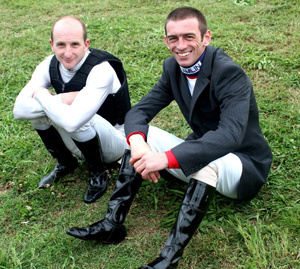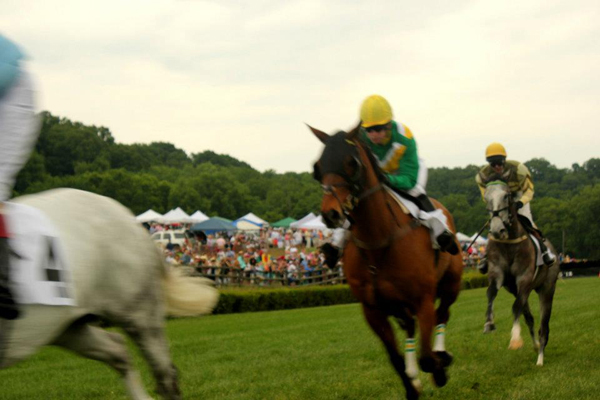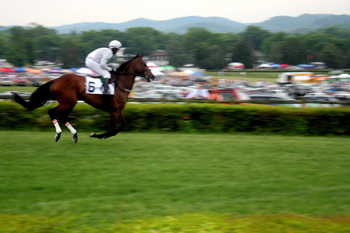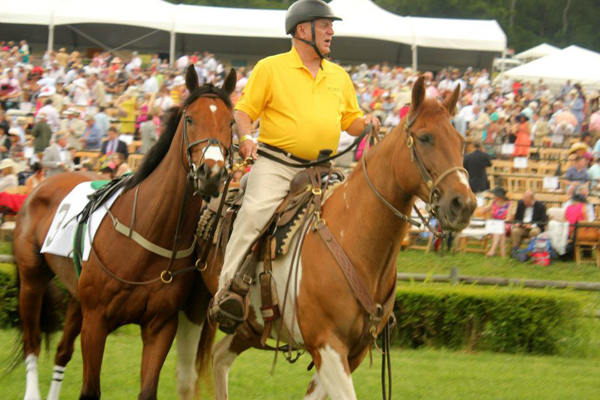
Brian Crowley (left) won the largest purse of the day, but lost his horse, Arcadius, following the race. Photos by Landin E. King.
When the bell signaling the horses from the stables sung out, few could predict the spectacle that would soon transpire.
As the rain turned into a drizzle and the sun began to shine through a white glaze of clouds, the young Irish rider Brian Crowley was ready for The Calvin Houghland Iroquois, a three-mile race of hurdles and flat ground with a $150,000 pay out, the highest of the day.
In the 2011 season, and after participation in most of the 35 Steeplechase races throughout the country, Crowley came in second in total race wins and purses. Today’s Steeplechase would be dramatic for Crowley, win or lose.
Seven races would take riders from unknown athletes to builders of fortune for horse owners and gamblers. A total of $400,000 was at stake in this year’s event and of the seven races, each held a special meaning for riders and owners alike.
Gustav Dahl could be seen dressed in green and white among the veterans. The 17-year-old—the youngest jockey on the National Steeplechase Association circuit—is in his second year of competitive racing and hopes to add to an already impressive résumé.
Having recently finished his junior year at Franklin (Tenn.) High School, his first race at the Iroquois Steeplechase would be the Guilford Dudley Jr. Memorial Flat Race, a race he won the year before.
Beginning in early March and continuing through November, Steeplechase races host an estimated one million spectators. Participants in American steeplechasing travel the circuit from pockets of steeplechase interest in Pennsylvania, Maryland, Virginia, Kentucky, Tennessee and the Carolinas. Riders from around the world came to Percy Warner Park, where the Steeplechase course is located, to have fun as part of the rites of spring, a long-running Southern tradition.
Unlike the Kentucky Derby and other flat ground races where betting is a motivating factor for race day excitement, Steeplechase racing has become an event dedicated to raising money for charity.
While under-the-table betting does take place, most gambles are placed on the collision of personal style and Southern culture.
Since 1981, the Monroe Carell Jr. Children’s Hospital at Vanderbilt has been the official charity of the Iroquois Steeplechase and has received more than $9 million from the event proceeds.
Improvements to the Iroquois Steeplechase and the needed funds for year-round irrigation of the grounds are paid for by the Volunteer State Horsemen’s Foundation to provide benefits and enhancements for the Equestrian Center at Percy Warner Park.
When the moment arrived, Brian Crowley and his horse, Arcadius, galloped across the finish line in first place. Owned by Hudson River Farms and trained by Jonathan Sheppard, Arcadius had led a miraculous career of Steeplechase finishes. But against all odds there was disaster on the horizon even after the race was over. While being cooled down by trainers, Arcadius suffered an aneurism. With six veterinarians on the scene, there was no way of knowing the horse would experience such a tragedy. According the National Steeplechase Association located in Fair Hill, Maryland, safety of steeplechase athletes, both equine and human is the highest priority, and this was a sad moment for everyone, especially Crowley, who was too distraught to comment to reporters.
A statement on the Iroquois Steeplechase website concludes: “Like any top flight athlete, Arcadius was in top physical condition. Indeed, proof of his strength and stamina was decisively on display in his winning performance. Also like all great athletes, both animal and human, Arcadius enjoyed competing, as was obvious to everyone who worked with him. He simply loved to run.”
A love for competition and the loss of a champion culminated to a day shadowed by heartbreak. Crowley has been embraced as a true champion and it is the hope of race officials and fellow riders that he will continue to go forward winning despite this setback.
















